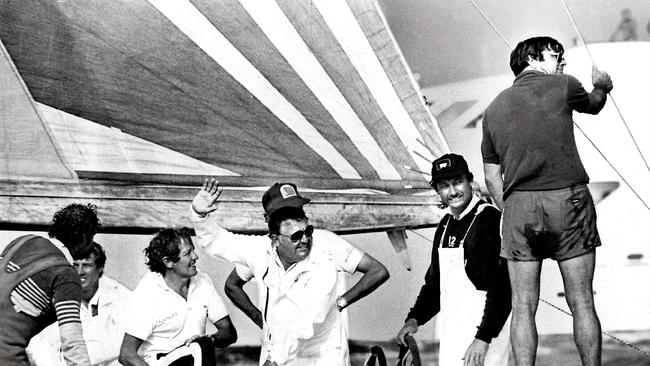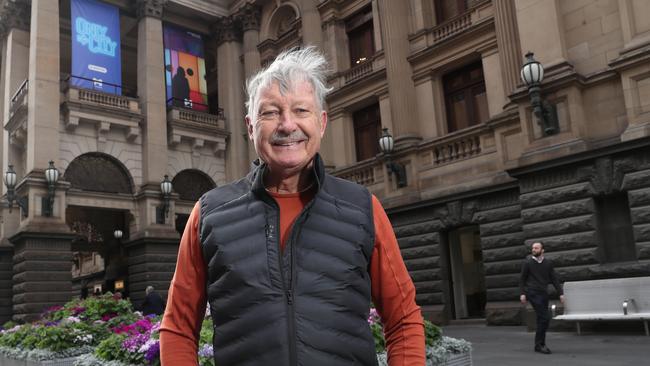Sail of the century: John Bertrand’s innovation theory
The celebrated skipper who led Australia to yachting glory in the America’s Cup says there’s plenty to be learned from that historic win in worlds of business and technology.

John Bertrand led the team responsible for arguably Australia’s most famous sporting victory, Australia II’s America’s Cup win in 1983, ending 132 years of American yachting dominance. Forty years ago a scrappy group of Australians, inspired by the exemplary leadership of skipper Bertrand and powered by Ben Lexcen’s secret winged keel, captured the imagination of the nation and highlighted the power of innovation and leadership in the face of overwhelming odds.
The victory was so historic that it led then-prime minister Bob Hawke to famously deride any boss who sacked a worker for taking the day off as a “bum”. Speaking with The List at Adelaide’s Southstart festival, Bertrand says there are many parallels with what his team pulled off 40 years ago and the challenges faced by Australia’s innovators and entrepreneurs. The interview has been lightly edited for clarity and brevity.
It had been more than 100 years of losing for Australia... What’s some of the history behind the America’s Cup race?
“The America’s Cup started off before the US Civil War, way back in 1851, and Queen Victoria had a challenge for any nation to race against the best of the British sailboats. It was an open competition and the new upstart nation called America decided to put a syndicate together, led by a man called Commodore John Stevens. They built a boat called the America, and that sailed across the Atlantic and took on the best of the British boats sailing around the Isle of Wight. The story goes that this Yankee yacht, America, was so far in front that Queen Victoria couldn’t see who was second. And she said, ‘who was second?’, and this fellow apparently said, ‘madam, there is no second’. And that was the basis of this crazy event called the America’s Cup. And since then, nations from around the world had tried to beat the United States, until a little country called Australia came along. And we beat them after many attempts.”
How did Australia get involved?
“It started off with Sir Frank Packer, way back in 1962. And the X-factor associated with America’s Cup is when you win it, the winning club, as it turns out, can change the rules. It’s called the deed of gift. And so, the Americans change the rules quite a lot. At one stage they were trying to ban us from using Microsoft programs because they were designed in the US, and so all the technology had to come out of the country, and that was challenging. Frank Packer, who was the middleweight boxing champion [of NSW] during the Depression, all tough, he said complaining to the New York Yacht Club was like complaining to your mother-in-law about your wife. So Frank started off in ‘62, and in ‘74 a man called Alan Bond, an upstart out of Western Australia who was technically broke at the time, he had the audacity to challenge for the America’s Cup. I’d just graduated from MIT in Boston with a Master of Science in aerodynamics and aerospace technology. I was assistant designer with a man called Ben Lexcen. Ben was different, he thought totally outside the box, it was fantastic. He invented the winged keel. We were sitting on the beach in Manly and he said, ‘look at these seagulls’. He said that they’ve got a brain smaller than a pea, and look at the way they’re landing and taking off. They landed perfectly every time. And that inspired the winged keel that revolutionised America’s Cup. Anyway, it was bloody hard to win. We did for a number of reasons and one is that we had to have the technology.”

When people ask “how did you do it?”, what do you say?
“The intellectual potential is enormous if people work together, compared to just doing your own solo thing. And that’s the big thing, to bring together, to get one-plus-one to equal three, and to create magic. We have this thing called culture, and we built this thing called a culture of trust. And the military, particularly special forces operations, have a lot to deal with particularly, as does our Australian Olympic swim program, which I’ve just retired as chairman. The basis of trust is built around integrity and honesty and transparency of communication, respect for each other, having fun. As Australians have got to have fun. So we built an organisation that was hard to kill off. Because we had this incredible trust environment, which was really hard for the Americans to peel apart. We had a technology program, which was pretty damn impressive, led by this crazy guy called Ben Lexcen and, ultimately, we had a world class sailing team, which never gave up.”
You mention in your recent Netflix documentary that you need an ego in order to succeed, is that true in business as well?
“To make stuff happen, you’ve got to break glass, and you’ve got to be a prick sometimes. I think you’ve got to have a big ego to do stuff because in some cases you’ve got nothing else. I’m very much team orientated; it’s all about empowering people, and that’s why this very simple word called trust is so important for any high-performance organisation.”

How did you manage to turn around what could fairly be called a losing culture for the Australian swim team? How did you come in and innovate such a large organisation?
“I was approached after the London Olympics because the Australian Olympic swimming program was considered a failure. I had no background in swimming at all. But I did have a background in building a high-performance team. I’ve not only dealt with America’s Cup, I did a startup that launched on NASDAQ in the late ’90s which broadcast sports over the internet. When I took over, Swimming Australia was dysfunctional. There was in-fighting, there’s no trust, there’s no vision. My added value was to really hammer this thing called the values and the culture of the organisation and to bring in a vision. I competed in the Olympics myself, and the Olympics is the cutting edge of human endeavour. My value was to bring a culture of really strong trust within the organisation. We had 55 people in our administration, and after two years, only five of them were left. It was too much scar tissue. Unfortunately, we couldn’t change the people, so we had to get new people in. And when we got the new people in with a new sense of values and vision and energy, it started to become a different organisation.
“I’d hoped that we could bring everyone along, but it just wasn’t to be. It was a new era, a new generation of thinking, and there was just too much blood in the water to be honest. When I became chairman, I didn’t know any of this stuff; I could walk into a room with no idea of who was trying to kill who. That naivety was great, I could just get on with the big picture.”
How did the turnaround ultimately go?
“Well at the 2016 Olympics in Rio our conversion rate was about 30 per cent. The team generated three gold medals, which was great, but about 30 per cent of athletes achieved their own personal best in their own events. Fast forward to Tokyo [in 2021] and it was the most successful swim program this country has ever achieved, which is something I’m very, very proud of. I’m just as proud of that as I am in terms of my involvement in winning the America’s Cup. The conversion rate was 70 per cent, which was a massive turnaround. The team generated nine Olympic gold and 20 medals in total, which was more than half of the entire Olympic team’s performance. It was built around this thing called trust, and a vision – and, in addition, having thought processes coming in from left field, by the military.”
The military?
“That’s right, the military way of thinking is that when you’re on the starting blocks, about to start your event, you are at peace with yourself. We call it racing to calmness. It’s really the ability to take your heartbeat, let’s say it’s running at 150 beats per minute, and you can bring it down to 120 and 110. The military know what heartbeat they need for each of their combatants for them to perform at optimum level, through breathing techniques and visualisation. So our kid is on the starting block, and he’s calm, and he smashes the world and Olympic records, and just won the Olympic gold. He gets out of the pool and says, ‘how easy was that? And, in addition, I can’t even remember the race’. Can you believe that? Well, it happened. And it happened multiple times. How easy was it to win the Olympic gold medal?
“It happens in the workplace, too. It’s called flow state, where things are slow motion, and you seem to be able to do stuff easily and it just kind of flows. Cate Campbell smashed the world record, not during the Olympics, but beforehand. She rang her mum and she said, ‘I can’t believe how easy it was, I’ve been trying for years to break that record’. So when we talk about the Olympic program, think about your own startups making business decisions when it really counts under extreme pressure. How do you actually pull that off in your major financial negotiations? Think about slow motion. Take control of your environment, and when you go back into the environment, take charge of yourself instead of the environment taking charge of you. The last race of the America’s Cup, it’s a four-and-a-half-hour race for God’s sake. And I would have made maybe 1000 key decisions as the skipper of the boat, but everything was slow motion thinking back on it. I had time. Now I didn’t get everything right, probably about 80 per cent. But we were able to win the damn thing.”
Any other secrets when it comes to innovating, and ultimately succeeding?
“I believe in the potential of people, and what they call the 10,000 hours system. You take 10,000 hours of perfect practice – not practice, but perfect practice – and you can become world class at anything you want. Whether that’s starting from scratch and becoming a chess player and being able to beat the Russians, whatever it is, I’m a great believer in the potential of people if they’re given the right environment. Now of course, you know, you fall on your face at different times, but with the right attitude you can do it. Can you buy attitude? That’s a hard one. Can you buy values? That’s a hard one. Because it sort of comes from the family environment or, you know, the journey of life in many ways – but, if indeed they have the right basis, the potential of people is enormous.
“Whether it’s startups, America’s Cups, Formula One motor racing – you need to have people who are committed and love what they’re doing.”







To join the conversation, please log in. Don't have an account? Register
Join the conversation, you are commenting as Logout